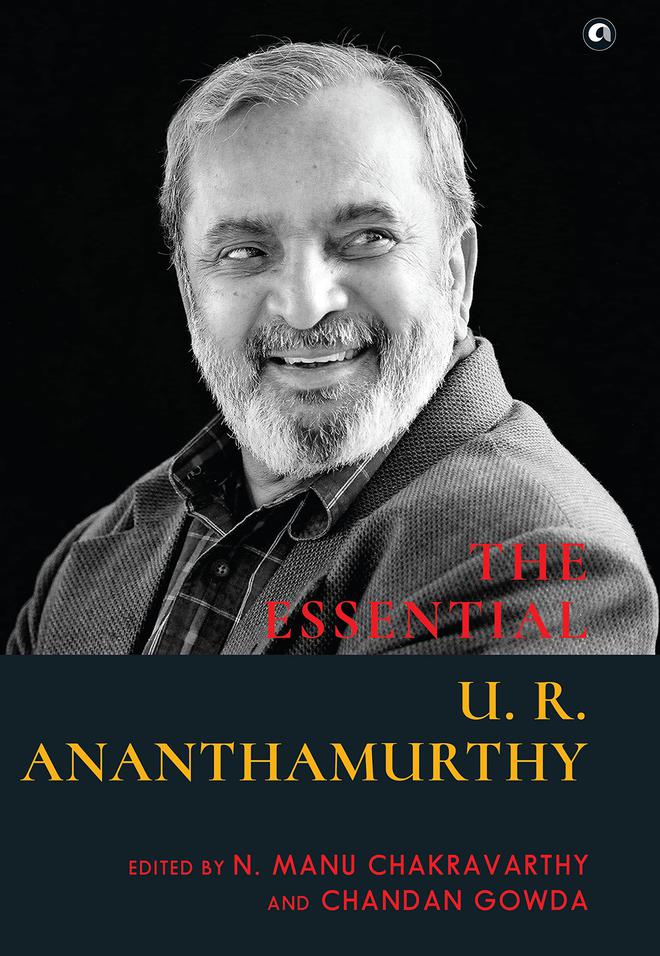What does it mean to read The Essential U.R. Ananthamurthy at a time when Prime Minister Narendra Modi’s rhetoric and roadshow could not help the BJP in Karnataka’s recent assembly election? In his last book, Hindutva or Hind Swaraj (2014/ 2016), U.R. Ananthamurthy (URA) vehemently criticised Modi’s political culture and genuinely practised what the Greeks called ‘parrhesia’ — speaking truth to power. The present volume, consisting of carefully and judiciously selected pieces, helps us grasp this liberal mind and his times.

Three volumes of URA’s writings in English — U.R. Ananthamurthy: An Omnibus (2008), Rujuvathu: Selected Essays (2014) and Hunt Bangle Chameleon (2014) — are already available to readers. This new anthology includes excerpts from four novels, five poems, six short stories, nine essays and speeches, besides excerpts from life narratives — Suragi (2012/ 2017) — and A Life in the World (2019), a book of interviews Chandan Gowda conducted with URA.
In URA’s vast repertoire, choosing an appropriate portion of text would be a challenging task, and the editors, who knew URA, the man and the writer, intimately, have done a fairly good job. For instance, the episode from the novel Samskara (1965/ 1976), where a dead man’s cremation becomes the focal point from which to analyse society, introduces readers to a slice of URA’s novelistic imagination. However, more editorial curation, such as placing URA and his writings in the proper context in a prefatory note before the beginning of each section, would have been of much help to the contemporary reader.
Understanding India
URA was, first and foremost, a thinker, and the thought in his writings galvanises us. The pieces in this volume offer glimpses of the formation of the thinker in him. Along with European writers such as Rilke, D.H. Lawrence and T.S. Eliot, two modern Indian minds that shaped URA were Ram Manohar Lohia and Gandhi. The extent of Lohia’s influence is clear from URA’s memoir Suragi and, more explicitly, from his essay on Lohia included here. Indeed, Samskara could not have taken shape without a Lohiaite’s vision.
However, under the activist’s spell, the earlier URA saw India as a society and later tried to grasp it as a civilisation through the Gandhian lens. Among five poems, freshly rendered in English by Gowda, two are on Gandhi, and there is also an essay on him. URA’s Gandhi is not an ideologue but a metaphor and a framework. His Hindutva or Hind Swaraj is composed in the moral idiom of Gandhi. As the section included here illustrates, it is a conversation with his own self as much as with his interlocutors.
Further, the essay, ‘Dalit Contribution to Indian Literature’, offers valuable insights into Kannada Dalit literature. But URA tried to understand the Dalit question not as an Ambedkarite but as a Gandhian though he appeared to have tried to reconcile both.
20th-century intellectual
Another picture of URA that emerges from this volume is that of a typical 20th-century public intellectual. Like Ashis Nandy, he too was a street fighter and struggled to understand past practices such as caste discrimination that continue to exist. For instance, in his long essay, ‘Why not worship in the nude?’, URA questioned the Karnataka government’s ban on women offering nude worship and asked it to respect the devotee’s faith while ensuring no commercial exploitation occurs. This kind of subtle distinction between the good and the evil in older customs compels us to read URA along with Nandy. Both thinkers do not reject the tradition outright but try negotiating with the contemporary.
Between the dichotomies of Kannada and English, traditional wisdom and modern science, liberal education and professional courses, mythical imagination and scientific rationality, casteless society and caste-based practices, and Hind Swaraj and ‘Hinduism’, URA chose the former. But he did not reject the latter outright either. As a critical insider, he did not want to break with tradition but to re-constitute it. Therefore, he became an object of severe criticism, and many Kannada intellectuals accused him of being a typical liberal Brahmin.
URA has, indeed, been a storyteller. Though trained as an academic at the University of Mysore and the University of Birmingham, he chose to articulate his sensibilities through metaphors and anecdotes; even his speeches and essays come alive as stories. URA may not be ranked among the world’s great storytellers like Marquez, but he is undoubtedly one of the world’s few politically committed writers. The reading of this volume brings forth this essential URA vividly.
The Essential U.R. Ananthamurthy
Ed. N. Manu Chakravarthy and Chandan Gowda
Aleph
₹899
The reviewer teaches English literature at Tumkur University.







